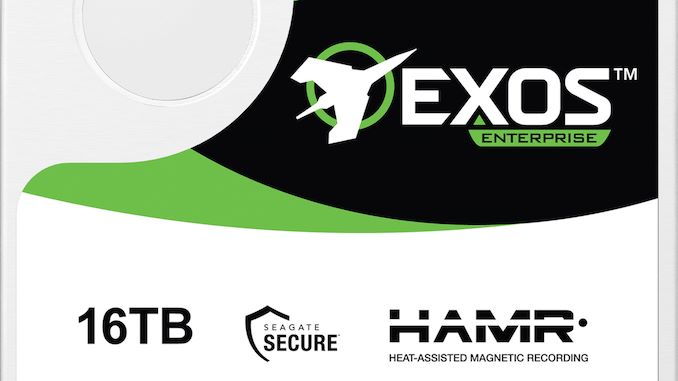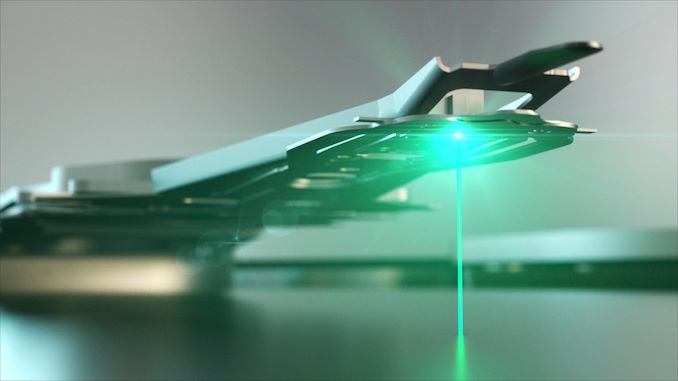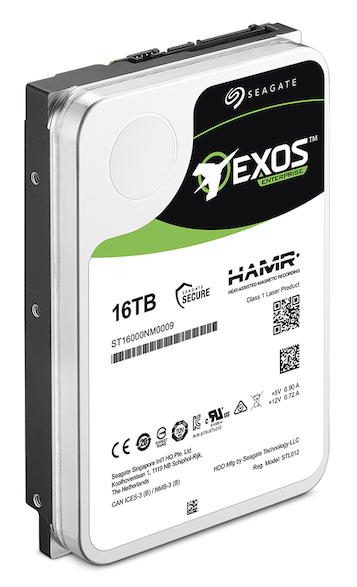Seagate Starts to Test 16 TB HAMR Hard Drives
by Anton Shilov on December 4, 2018 12:00 PM EST
Seagate on Monday disclosed that it had begun testing the industry’s first HAMR hard drive intended for evetualy commercial release. With a capacity of 16 TB, the HDD is being used primarily for internal tests to prepare for its high-volume launch and deployment in actual datacenters in the future. Separately, Seagate announced plans to introduce HAMR-based hard drives with a 20 TB capacity in 2020.
Seagate’s 16 TB Exos HDD featuring heat-assisted magnetic recording technology are drop-in compatible with existing servers and datacenters, which essentially means that their power consumption is 12 W or below. The hard drive is helium filled, but Seagate does not disclose the number of platters the HDD uses.
Right now, Seagate is testing its 16 TB Exos HDDs in a variety of benchmarks internally. Next the company will provide the drives to its customers, and once those customers qualify them Seagate will finally and officially launch the product.
“These are the same tests that customers use to qualify every new drive, including power efficiency tests, sg3_utils utilities that test SCSI commands to devices, standard smartmontools utility programs that will enable customers to characterize and compare HAMR drives in their environment right next to PMR drives, and several four-corners tests of reads, writes, random, sequential and mixed workloads,” said Jason Feist, Seagate’s senior director of enterprise product line management.
Related Reading:
- Seagate’s Multi Actuator Technology to Address HDD IOPS Woes
- Seagate Ships 35th Millionth SMR HDD, Confirms HAMR-Based Drives in Late 2018
- Seagate Confirms Plans for 12 TB HDD in Near Future, 16 TB HDD Due in 2018
- The Evolution of HDDs in the Near Future: Speaking with Seagate CTO, Mark Re
- Hard Disk Drives with HAMR Technology Set to Arrive in 2018
Source: Seagate












13 Comments
View All Comments
PeachNCream - Tuesday, December 4, 2018 - link
I've used a HAMR on a hard drive on more than one occasion. The outcome was not increased storage capacity.On a more serious note, I'm stoked about HAMR increasing mechanical HDD capacity since cold backup isn't a great idea on NAND and getting more iffy thanks to T/QLC. It already kind of sucked with MLC so I still feel like its wise to keep some sort of more durable (in terms of writes and longevity as opposed to physical impact resistance) storage medium around to keep my cat pics safe.
HardwareDufus - Tuesday, December 4, 2018 - link
16TB means I will never have to delete any of my Fav Cat VideosAlexvrb - Tuesday, December 4, 2018 - link
"Cat" videos, I get your drift, wink wink. Hey look, 8K eats up a lot of space, so you might need a bigger Hard drive down the road.PeachNCream - Thursday, December 6, 2018 - link
I actually do have a lot of photos and video of my cat doing various things. She's my itteh bitteh fuzzeh snuggle bunneh and I luff her lots!Alexvrb - Tuesday, December 4, 2018 - link
HAMRs are nice but MAHAMR is the best HAMR.rahvin - Tuesday, December 4, 2018 - link
I'm curious what the power use of these drives are, they are using significant amounts of power to heat the drive plate. I can see each of these drives using double-digit watts during writing. This will likely throw off server energy math quite badly.Death666Angel - Tuesday, December 4, 2018 - link
From the article: "their power consumption is 12 W or below."Since only a tiny amount of the platter needs to be heated each time I would not assume excess energy consumption.
rahvin - Wednesday, December 5, 2018 - link
12W is double a spinning disk which is typically 6w (they can use more while spinning up). As I said this is likely to throw off server energy math in dense installations. In addition the 6W of heat added is likely to impact rack heat designs based around the typical 6w consumption.mkozakewich - Wednesday, December 5, 2018 - link
"HAMR heads integrated in customer systems consume under 200mW power while writing..."https://blog.seagate.com/intelligent/hamr-next-lea...
So it's about two tenths of a watt, or 1.6% of the total power budget of 12 W.
rahvin - Wednesday, December 5, 2018 - link
200mW/s is a significant amount of energy. Especially if you have 48 or 64 of these disks in 4U.